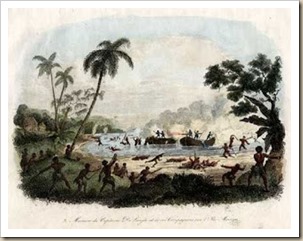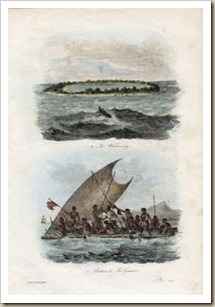During the second half of the 18th century, a number of major expeditions to the Pacific by French and British explorers revealed previously unknown population settlements and their different customs. James Cook undoubtedly contributed the greatest discoveries, but French explorers also contributed greatly to western knowledge of the Pacific region.
The French Admiralty, supported by King Louis XVI, sent the distinguished naval commander and oceanographer, Jean-Francois de Galaup, Comte de La Perouse (1741-1788), with Boussole and Astrolabe between 1785 and 1788, to continue the exploration of the Pacific that had been so widely charted by Captain Cook until his death in the Hawaiian Islands in 1779.
La Perouse travelled via Teneriffe, Brazil, Chile, Easter Island, and from the Spanish missions in California to the north-west coast and the Hawaiian Islands. He crossed the Pacific to the Philippines, China, Taiwan, Korea, and north to Tartary and Kamchatka. La Perouse sent despatches of discoveries as he travelled, so that news was received back in France. After receiving new instructions, the ships sailed south to the Samoan group of islands and on to Botany Bay in New South Wales, Australia.

La Perouse arrived at Botany Bay on 26th January 1788, just as Governor Phillip and the First Fleet were establishing the British settlement at Port Jackson. On 10th March La Perouse left to continue his travels, but was never heard from again. When no reports were received in France, the Government sent an expedition in search of La Perouse during 1791, 1792, 1793, and 1794. The disappearance of La Perouse, 220 crew, and the French frigates Boussole and Astrolabe remained a mystery for nearly forty years.
Compiling the information and illustrations from the journals that La Perouse had sent back from their ports of call, in 1798 Voyage de La Perouse Autour du Monde (Voyage of La Perouse Around the World) was published as an account of his expedition. The charting of La Perouse, his discoveries of native settlements and their customs, as well as technical and graphic reports by the artists and scientists on board his ships provided a wealth of new information - particularly in the Pacific.
In the late 18th and early 19th centuries, the voyages of discovery of new lands the other side of the world were so avidly followed back in Europe that they appeared in a number of publications of other explorers. Jules Sebastien Cesar Dumont d'Urville (1790-1842), was a French naval officer who combined engravings from the drawings by official expedition artist Louis Auguste de Sainson (1801-1887), with sketches and engravings from previous voyages. Voyages Pittoresque Autour du Monde (Picturesque Voyages Around the World) comprised "a general resume of the voyages of the discoveries of Magellan, Tasman, Dampier, Anson, Byron, Wallis, Carteret, Bougainville, Cook, LaPerouse, G. Bligh, Vancouver, D'Entrecasteaux, Wilson, Baudin, Flinders, Krunsenstern, Porter, Kotzebue, Freycinet, Bellinghausen, Basil Hall, Duperrey, Paulding, Dumont d'Urville, Lutke, Dillon, Laplace, Morrel, etc." It was published in Paris in 1834-1835, under the direction of d'Urville.
Rare early engravings of the intrepid explorers' discoveries in the Pacific are to be found on our website at http://www.antiqueprintclub.com/c-64-views-nzpngpacific.aspx